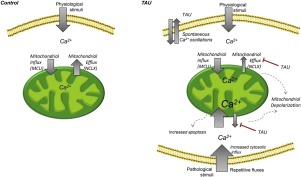当前位置:
X-MOL 学术
›
Cell Calcium
›
论文详情
Our official English website, www.x-mol.net, welcomes your
feedback! (Note: you will need to create a separate account there.)
Tau inhibits mitochondrial calcium efflux and makes neurons vulnerable to calcium-induced cell death.
Cell Calcium ( IF 4.3 ) Pub Date : 2019-12-24 , DOI: 10.1016/j.ceca.2019.102150 Elena Britti 1 , Joaquim Ros 1 , Noemi Esteras 2 , Andrey Y Abramov 2
Cell Calcium ( IF 4.3 ) Pub Date : 2019-12-24 , DOI: 10.1016/j.ceca.2019.102150 Elena Britti 1 , Joaquim Ros 1 , Noemi Esteras 2 , Andrey Y Abramov 2
Affiliation

|
Aggregation or phosphorylation of the microtubule-associated protein tau is the pathological hallmark in a number of diseases termed tauopathies, which include the most common neurodegenerative disorder, Alzheimer's disease; or frontotemporal dementia, linked to mutations in the gene MAPT encoding tau. Although misfolded tau has strong familial and histopathological (as in intracellular tangles) association with neurodegenerative disorders, the cellular mechanism of tau-induced pathology remains to be controversial. Here we studied the effect of tau on the cytosolic and mitochondrial calcium homeostasis using primary cortical cultures treated with the protein and iPSC-derived neurons bearing the 10 + 16 MAPT mutation linked to frontotemporal dementia. We found that incubation of the primary cortical co-cultures of neurons and astrocytes with tau induced spontaneous Ca2+ oscillations in the neurons, which were also observed in iPSC-neurons with the 10 + 16 MAPT mutation. Importantly, tau inhibited mitochondrial calcium efflux via the mitochondrial Na+/Ca2+ exchanger (NCLX) in both neurons and astrocytes. This inhibition led to mitochondrial depolarisation in response to physiological and pathological calcium stimuli and made these cells vulnerable to calcium-induced caspase 3 activation and cell death. Thus, inhibition of the mitochondrial NCLX in neurons with misfolded or mutated tau can be involved in the mechanism of neurodegeneration.
中文翻译:

Tau抑制线粒体钙外流,并使神经元易受钙诱导的细胞死亡的影响。
微管相关蛋白tau的聚集或磷酸化是许多称为tauopathies的疾病的病理学标志,其中包括最常见的神经退行性疾病阿尔茨海默氏病;或额颞叶痴呆,与编码tau的MAPT基因突变有关。尽管错折叠的tau与神经退行性疾病有很强的家族和组织病理学关系(如细胞内缠结),但tau诱导的病理学的细胞机制仍存在争议。在这里,我们使用经蛋白和iPSC衍生的神经元处理的tau对胞质和线粒体钙稳态的影响进行了研究,其中iPSC衍生的神经元带有与额颞痴呆相关的10 + 16 MAPT突变。我们发现,与tau一起孵育的神经元和星形胶质细胞的主要皮质共培养物诱导了神经元中的自发性Ca2 +振荡,在具有10 + 16 MAPT突变的iPSC神经元中也观察到了这种情况。重要的是,tau通过神经元和星形胶质细胞中的线粒体Na + / Ca2 +交换子(NCLX)抑制线粒体钙外流。这种抑制导致对生理和病理性钙刺激的线粒体去极化作用,并使这些细胞易受钙诱导的caspase 3活化和细胞死亡的影响。因此,tau折叠错误或突变的神经元中线粒体NCLX的抑制作用可能与神经变性的机制有关。tau通过神经元和星形胶质细胞中的线粒体Na + / Ca2 +交换子(NCLX)抑制线粒体钙流出。这种抑制导致对生理和病理性钙刺激的线粒体去极化作用,并使这些细胞易受钙诱导的caspase 3活化和细胞死亡的影响。因此,tau折叠错误或突变的神经元中线粒体NCLX的抑制作用可能与神经变性的机制有关。tau通过神经元和星形胶质细胞中的线粒体Na + / Ca2 +交换子(NCLX)抑制线粒体钙流出。这种抑制导致对生理和病理性钙刺激的线粒体去极化作用,并使这些细胞易受钙诱导的caspase 3活化和细胞死亡的影响。因此,tau折叠错误或突变的神经元中线粒体NCLX的抑制作用可能与神经变性的机制有关。
更新日期:2019-12-25
中文翻译:

Tau抑制线粒体钙外流,并使神经元易受钙诱导的细胞死亡的影响。
微管相关蛋白tau的聚集或磷酸化是许多称为tauopathies的疾病的病理学标志,其中包括最常见的神经退行性疾病阿尔茨海默氏病;或额颞叶痴呆,与编码tau的MAPT基因突变有关。尽管错折叠的tau与神经退行性疾病有很强的家族和组织病理学关系(如细胞内缠结),但tau诱导的病理学的细胞机制仍存在争议。在这里,我们使用经蛋白和iPSC衍生的神经元处理的tau对胞质和线粒体钙稳态的影响进行了研究,其中iPSC衍生的神经元带有与额颞痴呆相关的10 + 16 MAPT突变。我们发现,与tau一起孵育的神经元和星形胶质细胞的主要皮质共培养物诱导了神经元中的自发性Ca2 +振荡,在具有10 + 16 MAPT突变的iPSC神经元中也观察到了这种情况。重要的是,tau通过神经元和星形胶质细胞中的线粒体Na + / Ca2 +交换子(NCLX)抑制线粒体钙外流。这种抑制导致对生理和病理性钙刺激的线粒体去极化作用,并使这些细胞易受钙诱导的caspase 3活化和细胞死亡的影响。因此,tau折叠错误或突变的神经元中线粒体NCLX的抑制作用可能与神经变性的机制有关。tau通过神经元和星形胶质细胞中的线粒体Na + / Ca2 +交换子(NCLX)抑制线粒体钙流出。这种抑制导致对生理和病理性钙刺激的线粒体去极化作用,并使这些细胞易受钙诱导的caspase 3活化和细胞死亡的影响。因此,tau折叠错误或突变的神经元中线粒体NCLX的抑制作用可能与神经变性的机制有关。tau通过神经元和星形胶质细胞中的线粒体Na + / Ca2 +交换子(NCLX)抑制线粒体钙流出。这种抑制导致对生理和病理性钙刺激的线粒体去极化作用,并使这些细胞易受钙诱导的caspase 3活化和细胞死亡的影响。因此,tau折叠错误或突变的神经元中线粒体NCLX的抑制作用可能与神经变性的机制有关。











































 京公网安备 11010802027423号
京公网安备 11010802027423号